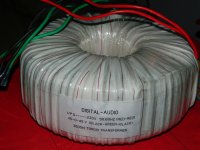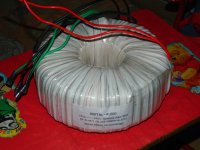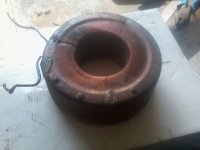construya un transformador toroidal casero
Hello
greetings can anyone verify how accurate is the torridal winding information
given on this site any inputs will be useful to diyers to make their own torridal transformers
warm regards
Andrew🙂
Hello
greetings can anyone verify how accurate is the torridal winding information
given on this site any inputs will be useful to diyers to make their own torridal transformers
warm regards
Andrew🙂
that depends on the quality of your core material...
some info here....Silicon Steel Toroidal Cores - In Stock
some info here....Silicon Steel Toroidal Cores - In Stock
my diy TORRIDAL TRANSFORMER
Hello
greetings DIYed this torridal at home
PRIMARY SWG 14 swg
SECONDARY 11SWG
secondary voltage 45 0 45 AC
how much VA is this transformer approximately just new to winding transformers
excuse my limited knowledege
warm regards
Andrew😉
Hello
greetings DIYed this torridal at home
PRIMARY SWG 14 swg
SECONDARY 11SWG
secondary voltage 45 0 45 AC
how much VA is this transformer approximately just new to winding transformers
excuse my limited knowledege
warm regards
Andrew😉
Attachments
The VA rating of the transformer will be down to the core size and material, whether or not you will get the maximum output will be down to the design of the windings.
The label states 3600W.
That could be 3600VA
The 14swg primary has a current rating of around 10A. That indicates a 2300VA input rating.
The 11swg secondary has a current rating of around 21A. That indicates a 1900VA output rating.
Current rating based on 3.1A/mm²
It's probably safe to say 2kVA for this transformer. But monitor the temperature if you intend using most (or more) of this capability.
You might find that 3kVA is realistic if it stays cool.
That could be 3600VA
The 14swg primary has a current rating of around 10A. That indicates a 2300VA input rating.
The 11swg secondary has a current rating of around 21A. That indicates a 1900VA output rating.
Current rating based on 3.1A/mm²
It's probably safe to say 2kVA for this transformer. But monitor the temperature if you intend using most (or more) of this capability.
You might find that 3kVA is realistic if it stays cool.
Last edited:
very bad idea calculate va power of transformer from wire gauge.you cannot get more watt than core transforming watt.core area is important and material too.as your thinking, it will become 10000va if some one wrap 5 no.swg wire on it.
the core VA rating being higher than power derived from copper current densities
is the usual case for transformers, and keeping it means a cooler running traffo...
is the usual case for transformers, and keeping it means a cooler running traffo...
Hello
greetings EI transformers designing hints can be found on the net even softwares
are there but TOROIDAL TRANSFORMERS designing hints are hard to find wish this thread can grow with useful information so diyers can make torridal transformers just finished
a 90 0 90 volt ac 3kw torridal for my dclass amp
warm regards
Andrew
greetings EI transformers designing hints can be found on the net even softwares
are there but TOROIDAL TRANSFORMERS designing hints are hard to find wish this thread can grow with useful information so diyers can make torridal transformers just finished
a 90 0 90 volt ac 3kw torridal for my dclass amp
warm regards
Andrew
very bad idea calculate va power of transformer from wire gauge.you cannot get more watt than core transforming watt.core area is important and material too.as your thinking, it will become 10000va if some one wrap 5 no.swg wire on it.
Actually a transformers output IS limited my the resistive losses in windings. The core size is not a part of this equation.
However , to accomodate sufficient wire area for a certain power and voltage, and to prevent core saturation(sufficient number of turns) you size your core. Fex using formulas.
But the basic is that power output is not related to core size.
But the basic is that power output is not related to core size.[/QUOTE]
yes i agree with you but this is only type or way to telling so that other person can understand.i also read two book about transformer when i was in college.but when i came in professional field the all theory didn't help me.these all things are related in practicals.when you want so much power(2500va) then you have to cover all voltage (220 or 110) in primary with a low caliper wire with minimum length for do this core size should be big where turn per volt will be minimum.this will increase the automatic ampere rating of wire.so core size is matter in transformer winding not in theory.this is forum where we can learn from each other.happy diwali.
yes i agree with you but this is only type or way to telling so that other person can understand.i also read two book about transformer when i was in college.but when i came in professional field the all theory didn't help me.these all things are related in practicals.when you want so much power(2500va) then you have to cover all voltage (220 or 110) in primary with a low caliper wire with minimum length for do this core size should be big where turn per volt will be minimum.this will increase the automatic ampere rating of wire.so core size is matter in transformer winding not in theory.this is forum where we can learn from each other.happy diwali.
But the basic is that power output is not related to core size.
on the contrary...core size has everything to do with output power...
The core has to have "sufficient" material in order to successfully magnetise and demagnetise during each cycle of the secondary supply cycle.
Of course it is possible to use a much bigger core than necessary in order to accommodate the size of the windings.
HOWEVER, it IS NOT possible to use a smaller core than necessary.
Our Eastern friends often under spec transformer cores running them at magnetising fluxes which don't exactly give them a long life.
The MOD and NASA as two examples over spec their transformer cores.
The result of this is that we often see two transformers with similar ratings but very different in physical size.
Of course it is possible to use a much bigger core than necessary in order to accommodate the size of the windings.
HOWEVER, it IS NOT possible to use a smaller core than necessary.
Our Eastern friends often under spec transformer cores running them at magnetising fluxes which don't exactly give them a long life.
The MOD and NASA as two examples over spec their transformer cores.
The result of this is that we often see two transformers with similar ratings but very different in physical size.
katieandad,all professional vender try to use small core as possible because they want much profit.where concern about diy why we do that because we need quality not profit.
Hi Rohin
greetings i have some cores its cheap here 1$ a kilo i will catch up with you
warm regards
Andrew
greetings i have some cores its cheap here 1$ a kilo i will catch up with you
warm regards
Andrew
I shall clarify, so it is more understanableon the contrary...core size has everything to do with output power...
all formulas sizing cores based on power output are based on approximations and assumptions of current density, winding space etc. Ie the core has to be so big that your windings fit in window, and the size of windings is detemined by resisitive losses and necessary insulation.
And of course the core has to have sufficient area not to saturate.
Your core could be U shaped and each leg a meter long, you only lose some efficiency due to stray field and more magnetising losses, and of course affect parasitic, but the power rating would be the same, limited by winding losses
Unless the core is undersized and moving towards saturation. Perhaps a little less, because core losses increases and you are still limited by windings, ie less power is avaliable as net ouput.
But a normal small transformer has about 80-90 % of the loss in windings at full rating.
A good example of underzised transformers are microwave transformers, which are designed with high losses, both windings and core. Minimize iron to make it cheap and cram the winding inthere , and to get sufficient turns so it wont saturate entirely make the current density of the windings higher, iemore Loss.
But it aint designed for continous use.
I am not. I am explaining that the core needs to be sufficient large to accomodate a winding with a certain loss.
So if you want to build a 500VA transformer with 2500 Vrms isolation? That means you end up with a certain amount of copper, based on the losses in the windings. Well what is the smallest core you can fit this on and still have acceptable losses? Losses caused by magnetisation.
So if you want to build a 500VA transformer with 2500 Vrms isolation? That means you end up with a certain amount of copper, based on the losses in the windings. Well what is the smallest core you can fit this on and still have acceptable losses? Losses caused by magnetisation.
800va toroidal
outer dia 14.5cm ,hole dia 7cm,height 5cm and weight 4.5kg.this can support 1000va but rating is 800va on it.i open secondary winding for check the primary number and found 21swg wire is used. no.of turn per volt is 2.37 and 12 years old.input voltage is 230 and output is 4 into 24ac with 8.50 ampere.i hope this information useful.
outer dia 14.5cm ,hole dia 7cm,height 5cm and weight 4.5kg.this can support 1000va but rating is 800va on it.i open secondary winding for check the primary number and found 21swg wire is used. no.of turn per volt is 2.37 and 12 years old.input voltage is 230 and output is 4 into 24ac with 8.50 ampere.i hope this information useful.
Attachments
Hi Rohin
greetings here in my place we get torridals like in the picture posted above this is
4 ampere core as they call it here so if i am right 4amps* 220 volts = 880 WATTS even
the turn ratio is right i have a 12 AMPERE CORE need maximum amperes @ 70 0 70
ac for my stereo amp if possible please post more transformer details which can be useful
to many diyers
warm regards
Andrew
greetings here in my place we get torridals like in the picture posted above this is
4 ampere core as they call it here so if i am right 4amps* 220 volts = 880 WATTS even
the turn ratio is right i have a 12 AMPERE CORE need maximum amperes @ 70 0 70
ac for my stereo amp if possible please post more transformer details which can be useful
to many diyers
warm regards
Andrew
Hello
greetings EI transformers designing hints can be found on the net even softwares
are there but TOROIDAL TRANSFORMERS designing hints are hard to find wish this thread can grow with useful information so diyers can make torridal transformers just finished
a 90 0 90 volt ac 3kw torridal for my dclass amp
warm regards
Andrew
The reason I suspect is because the toroid's are designed by CAD packages. If you think about it the process is highly complex and has almost zero advantage if hand made. The E and I transformer is totally different and has great advantages if lets say you took a month to make one in your spare time. I have seen a bicycle wheel used to feed it on and a simple feeding device.
One thing I can tell you. Low VA extra windings on toroids are very easy. Just wind lets say 5 turns and see what you get. Feedback windings also. This can remarkably improve a design. For example add 10 V to the driver rails of an amplifier cheaply. Build a pre amp supply. It is surprising how few turns needed very often. As it will be low VA often no calculation of wire size required, small is best. If a toroid is noisy which is a down side of how some are made epoxy potting helps and seems usually to help dissipation. Test for yourself that. Seemed so at 100 VA to me. DC blocking devices help . ESP's Rod Elliot has a design I have used.
- Status
- Not open for further replies.
- Home
- Amplifiers
- Power Supplies
- Torridal Transformer designing


